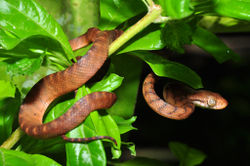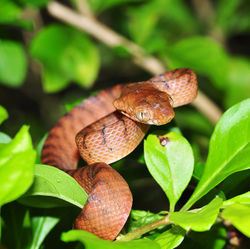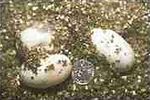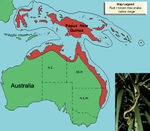Brown tree snake
| Brown tree snake |
|---|

|
| Scientific Classification |
| Scientific Name |
|
Boiga irregularis |

|
| Brown tree snake on tree branch |
The brown tree snake (Boiga irregularis) is an invasive specie of snake. It was accidentally brought to the island of Guam from northern Australia about 50 years ago and is still currently causing problems. This particular snake is about 8 feet long, eat small mammals, bird eggs and are mildly poisonous. this snake has taken refuge in other animals shelters and is eating plants and animals native to the island. this snake is a problem because it is slowly but surely causing other animals to become scarce and driven out. The snakes don't reproduce often, about once every year, but they lay about 15 eggs so the snakes are everywhere on the island.
when the snakes were fist brought to Guam, they weren't a problem but now have wiped out a few different species of bats birds and lizards, even straying as far as chasing their prey into buildings and scaring people. people are trying to control the snake problem but since the snake lives about 15 years and they are so many of them, they are a hard specie to control.
Body Design
The Brown tree snake is mildly poisonous and has a big head and eyes, that are large and protruding with vertical pupils. [2]Its large vertical pupils open wide at night to facilitate hunting. Usually, the brown tree snakes eat small animals, including mammals, birds, lizards, and bird's eggs. When they young, their lengths are up to 18 inches long, however, when they are fully grown, their lengths will be over 8 feet long. Furthermore, they will weigh about 2.3kg. [3]
Snake with yellowish to dark brown back, sometimes with mottled bands. Underside is cream to yellow colored. The snake active at night and lives on trees. [4]Brown tree snakes have a long slender body that helps to climb trees, vines, and rocks and hide in small spaces.
Life Cycle
The brown tree snake is thought to only reproduce in the winter and warm summer months because of the whether conditions. No mating has been found about the Brown Tree Snake in the wild so we don’t actually know in which seasons of life they produce in. In Australia where they originated, the females are observed to only lay eggs once every year, but they don’t know how they reproduce in Guam. [5] a lot of eggs have been found anywhere but it is estimated the females lay about 4 to 12 eggs underground. The brown tree snake babies hatch from their eggs in about 90 days and the brown treesnake reach sexual maturity in 3 years after they hatch.[5] [6]
The brown tree snake lives for about 12-15 years.[7]They are not very big, only about 15 inches in length. but because the female tree snake produces so many eggs they are basically everywhere on the island of Guam. [7] but because there are so many of these tree snakes running rampant through the island, they are becoming a problem, eating other natural organisms food and taking their shelter.[8]
Ecology
The Brown Tree Snake is native to Papua New Guinea, Indonesia, the Solomon Islands, and northeastern Australia. [9] It was also accidentally introduced to Guam in the 1940s. [10]. It is found in all different types of habitats, from farmlands, to coastlands, wetlands, and even urban areas. It is found in elevations of up to 1,400 feet. It hides during the day in trees or caves and comes out to eat during the night. [11] In the habitats where it lives, it is very abundant. In Guam, for instance, it is estimated that there are up to 20 snakes per acre of jungle. [12]
It is a nocturnal snake and eat all kinds of small animals, such as lizards, birds, bird eggs, and frogs. Younger, smaller snakes usually prey on smaller animals, such as lizards, and as they grow they eat bigger prey, such as small mammals. They often enter residential areas because of the large amount of rodents and poultry, and sometimes even enter buildings while chasing their prey. [13] When they colonize a new habitat, they are known for destroying whole populations of other species that they prey on. After the snake was introduced to Guam, it was responsible for wiping out several different species of birds and two species of bats. It is unclear if the Brown Tree Snake has any predators, but some studies have shown that monitor lizards, red bellied black snakes, and cane toads may prey on them. [14]
Invasive Species
Location and Method of Introduction
The island of Guam is a nice warm island in the Pacific Northwest Ocean. Unfortunately, this makes it a likely habitat for the invasive brown tree snake. The brown tree snake is believed to have been brought to the island by U.S military ships in World War 2. Since the brown tree snake can hide in small areas, it is likely that the snakes hid out in the cargo and were released onto the island of Guam. [15] [16]
Environmental Impact
There are lots of brown tree snakes in Guam(estimated at more than 3,000 per square mile). Also, the birds that make up a small part of the life of a forest, are important for pollination, spreading seeds around the forest and controlling insects that feed on plants. Guam lost most of its native birds because of the brown tree snakes. [17]
Control Methods
There are several methods used to attempt to control the damage of the brown tree snake. Some methods are barriers, traps with bait, biological control, pathogens, and chemicals. Barriers are the most common control method,and can be temporary or permanent. Temporary barriers are less protective and require more work to keep them up. Some temporary methods are the use of nets, and shade cloths. Permanent methods are often preferred and more protective. A few permanent methods include masonry, metal mesh, vinyl, and building seawalls. [18]
Video
References
- ↑ Boiga irregularis Wikispecies. Web. last modified 9 March 2016. Author unknown
- ↑ http://www.qm.qld.gov.au/Find+out+about/Animals+of+Queensland/Reptiles/Snakes/Common+and+dangerous+species/Brown+Tree+Snake#.WBrE7ZPhBAY] "Queensland museum". Web. 2 November,2016-accessed.unknown author.
- ↑ Jones, Gina. Brown Tree Snake Anstaskforce. Web. 11 November, 2016-accessed.
- ↑ http://dlnr.hawaii.gov/hisc/info/invasive-species-profiles/brown-tree-snake/] "Hawaii invasive Species Council". Web. 2 November,2016-accessed.unknown author.
- ↑ 5.0 5.1 Lellis,Vhttp://eol.org/pages/795579/details Boiga irregularis 'Encyclopedia of life'. Web. June 16, 2014
- ↑ 7.0 7.1 Myer,Jeffereyhttp://www.defenders.org/snakes/basic-facts ‘facts about snakes’. Web. January 6, 2009
- ↑ Gad,Perryhttp://www.iucngisd.org/gisd/species.php?sc=54 ' GLOBAL INVASIVE SPECIES DATABASE'. Web. October 16, 2009
- ↑ National Biological Information Infrastructure (NBII) & IUCN/SSC Invasive Species Specialist Group (ISSG), Boiga irregularis (reptile), Global Invasive Species Database, Web. Update 16, Aug. 2009.
- ↑ Brown Tree Snake an Invasive Reptile, U.S. Department of Agriculture, Web. Jan. 2011, Author Unknown.
- ↑ National Biological Information Infrastructure (NBII) & IUCN/SSC Invasive Species Specialist Group (ISSG), Boiga irregularis (reptile), Global Invasive Species Database, Web. Update 16, Aug. 2009.
- ↑ Brown Tree Snake an Invasive Reptile, U.S. Department of Agriculture, Web. Jan. 2011, Author Unknown.
- ↑ National Biological Information Infrastructure (NBII) & IUCN/SSC Invasive Species Specialist Group (ISSG), Boiga irregularis (reptile), Global Invasive Species Database, Web. Update 16, Aug. 2009.
- ↑ Rafferty, John. Brown Tree Snake, Reptile. Encyclopedia Britannica. Web. Accessed 28 Oct 2016.
- ↑ Patrick, Lisa./ October 11, 2001/ brown-tree-snake/ “Columbia University”. Web. 7 November,2016-accessed.
- ↑ The Editors of Encyclopædia Britannica.Introduced Species Summary Project: Brown tree snake (Boiga irregularis) “Guam, Island, Pacific Ocean”. Web. 7 November,2016-accessed.
- ↑ unknown author.[ http://www.washington.edu/news/2008/08/21/brown-tree-snake-could-mean-guam-will-lose-more-than-its-birds-2/] "University of Washington". Web. 7 November,2016-accessed.
- ↑ Patrick, Lisa. Introduced Species Summary Project Brown tree snake (Boiga irregularis)] columbia.edu. Web. last edited October 11, 2001




